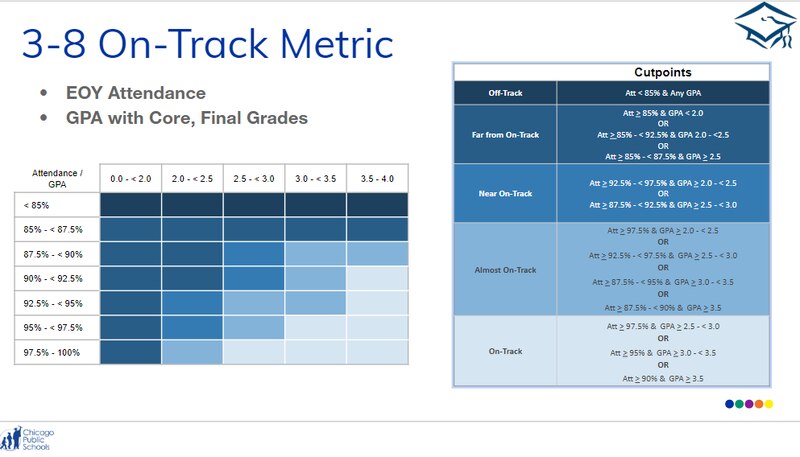Starting in September, Chicago elementary schools will be graded under new rules, ones that measure whether elementary students are primed for high school success.
The “3-8 On-Track” metric was approved last month by the new school board along with other revisions to how the district rates its schools, despite concerns about the speed of the shift and questions about its logic.
Related: Chicago school board approves new school ratings scale despite complaints and confusion
The changes update Chicago’s controversial School Quality Rating Policy, which assigns schools a rating on a numerical scale from 1-plus (the highest) to 3 (the lowest) based on factors like attendance and test score growth.
Here’s a closer look at the district’s new approach to rating elementary schools.
It creates an entirely new metric based off of an approach that has worked at the high school level.

The idea is to hold elementary schools responsible for preparing students for the next level, just like the ratings policy attempts with high schools. The district’s high school ratings formula already included an “on-track” metric for freshman that calculates grades and attendance to determine how prepared they are for graduation and college success.
Related: The data point that reshaped Chicago’s high schools
The previous model for rating elementary schools incorporated nine metrics, including student performance and growth on standardized test scores, a combined 60% of a school’s rating, and attendance, which accounted for 20%.
In the updated elementary rating system, the weight of attendance was cut in half, and the district introduced an on-track indicator as a 10th metric. It counts for 10% of a school’s rating, and considers attendance and grade-point average for students in grades 3-8 to determine whether they are on track for high school.
The more classes they attend, the lower the required GPA to stay on track. So for instance, students are on track if they attend at least 90% of school days and maintain a 3.5 GPA. But if they attend 97.5 % of school days, they’ll be considered on track if they have at least a 2.5 GPA. Students are considered off track regardless of their GPA if they have below 85% attendance.
School ratings, which are heavily reliant on test scores, factor strongly into families’ enrollment choices — at a district whose student population is declining. Affluent neighborhoods with more white residents offer a disproportionate concentration of highly rated schools. That’s one reason the Chicago Teachers Union argues that school ratings correlate more with socioeconomic status and race than they do school quality.
Related: Lessons from a Chicago school merger: Race, resilience, and an end-of-the-year resignation
Critics also warn about relying on attendance to calculate school ratings, because they say that factors outside of schools’ and educators’ control — poverty, illness, and trauma, among them — can influence whether or not students come to school and how they perform.
“It’s a shell game with attendance numbers,” said Troy LaRaviere, president of the Chicago Principals and Administrators Association about the new elementary school metric. “It will still hurt communities where attendance is an issue as a result of community factors, not anything the school is doing.”
The district, however, sticks by findings from its internal research team and the University of Chicago Consortium on School Research that a student’s attendance is a powerful predictor of their future success.
Some question whether retrofitting a metric for high schoolers is developmentally appropriate for younger children.
Can a third grader really be “on track” in the same way that a high school freshman is? And is it fair to apply such a framing for children’s learning experience at such a young age? School board members raised these questions, as well as concerns that the range of grading practices across the district’s 479 elementary schools might provide an unreliable measure of school quality.
Related: Lightfoot vows new Chicago school board will stop making so many decisions behind closed doors
But some research indicates that grades and attendance better predict high school and college success than do test scores, according to Elaine Allensworth, director of the University of Chicago Consortium on School Research, whose studies helped inform the “on-track” formula for high schools. In 2014, Allensworth and other researchers found that students’ performance in grades 5 through 8 best predicted success in high school and college.
The consortium suggested the information could be harvested to forge a simple indicator measuring whether students are on track for high school graduation and college readiness. But Allensworth said that while the district’s new elementary school metric is inspired by their work, the consortium report never recommended applying it across the district via the School Quality Rating Policy. She also said the consortium’s research didn’t include students in third and fourth grade.
The school district said its own research at all grade levels found that “GPA and attendance were in fact the best predictors of students’ future success.” The district declined to provide a detailed description of its methodology and specific findings.
Related: How it feels to be Javion —16 and struggling to read in Chicago Public Schools
But Morgan Polikoff, a professor at the University of Southern California’s school of education, said he’s a fan of such early warning systems, as long as they trigger the proper response — “so it’s not just that this kid is off track, but what are we going to do with those kids who are struggling in the early grades?”
If it was up to him, he’d go “even earlier.”
“If a kid is a struggling reader, and they make it all the way to third grade and they’re still a struggling reader, that’s hard to overcome, let alone if they get to sixth grade or eighth grade.”
The metric was two years in the making, but at least one school board member questioned the process.
The first time many members of the public heard about the 3-8 On-Track metric was when the school board agenda dropped in late June, two days before the board meeting. But district leaders said they had been working on updating SQRP for at least two years, and convened more than 80 meetings with researchers, education policy experts, and educators to brainstorm the new policy.
Related: Speaking at a Chicago school board meeting is a feat of endurance for parents. It shouldn’t be.
However, the board’s lone dissenter, Dwayne Truss, declined to back the policy because he believed that the district fell short in engaging teachers and parents. (Board Vice President Sendhil Revuluri abstained from the vote.)
Schools chief Janice Jackson pledged to work on a community engagement plan for updates to the rating policy, and also suggested that a new board committee could focus on the rating policy.
This month, the board may consider requiring the district to post proposed new policies for public comment 30 days before a vote.
Related: Here are 7 big ways that Chicago school board meetings are changing
This is actually a stop-gap. Another rating system is at least 1½ years away.
In approving “SQRP 2.0,” as it’s known, the board issued the district a mandate to formulate a new school rating policy. But “SQRP 3.0” could take at least 1½ years to build, according to Jackson. So far, Chicago Public Schools hasn’t released an official timeline for developing the next phase of school ratings. District spokeswoman Emily Bolton wrote in an email that, “the district will provide an update when additional information is available to share.”
The new school rating policy nearly fell short of the five votes it needed to pass, but the measure passed after school officials raised concerns that a “no” on the policy would be too disruptive to elementary school principals waiting to see how they will be evaluated next year. A district spokeswoman wouldn’t elaborate on why the district did not want to keep its existing elementary rating system in place.
The stakes for schools are high.
Since 1995, the Illinois School Code has mandated Chicago Public Schools to designate schools as being in either good standing, needing remediation, or as probationary. The school board has the authority to decide the rating criteria.
When schools on probation (which tend to be in predominantly black and low-income communities) fail to substantially improve, the district can order new Local School Council elections, fire principals and staff, or reconstitute or close the school.
Given the stakes for schools, Allensworth acknowledged the risk that educators might adapt their teaching to benefit their rating but not necessarily help students learn, like teaching to the test, or inflating grades.
“That’s something we need to watch out for,” she said.
In addition to the city’s ratings, all Chicago schools receive a state rating based on a different formula. A low state rating also can trigger intervention via funds and support for school improvement.

